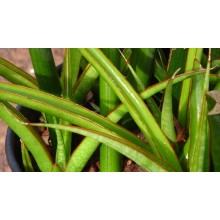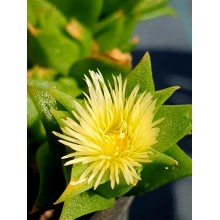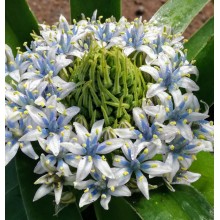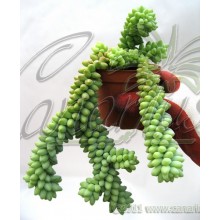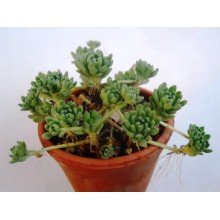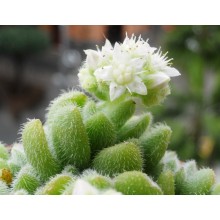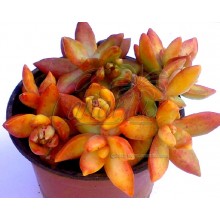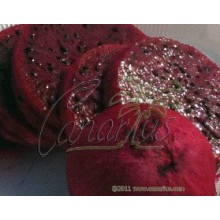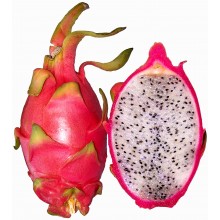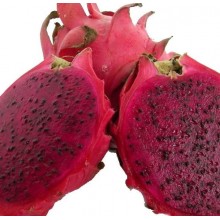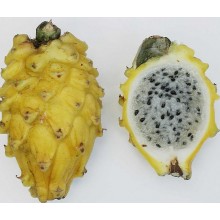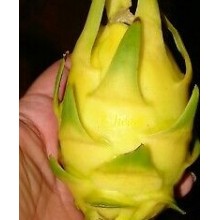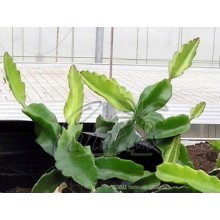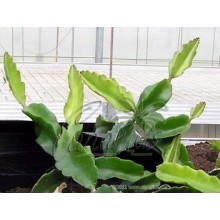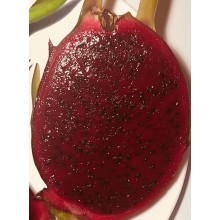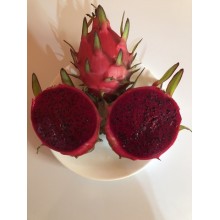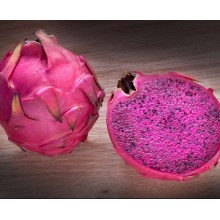Succulente Ci sono 628 prodotti.

I deserti del mondo e le zone secche ospitano le piante più interessanti. Canarius offre una selezione crescente di piante succulente di massima qualità, perché sono coltivate all'aperto, in pieno sole delle Isole Canarie.
I succulente o "piante grasse" sono specie di ritenzione di acqua, adattate alle condizioni di asciutto. Loro accumulano succum (succo, acqua) nelle loro foglie, steli o radici, e spesso mostrano un aspetto robusto e carnoso.
Sotto-categorie
-
Agave
Agave è un genere di piante grasse provenienti dall'America. Alcune specie crescono in zone fredde e possono sopportare un forte gelo, mentre altri vivono in climi tropicali. Alcuni sono piccoli nani e alcuni sono giganti, fino a 2 o 3 m di larghezza.
Le agavi resistenti al freddo possono creare un effetto esotico nel vostro giardino. Le specie agave fanno bella compagna di palme o cactus. Le agavi variegate sono incredibilmente ricercati dai collezionisti. Il nostro negozio web offre una selezione in continua evoluzione delle specie. Spediamo piante a radice nuda, se non diversamente specificato.
-
Aloe, Gasteria & Haworthia
Aloe, Gasteria e Haworthia sono tre generi correlate, comprese centinaia di piante succulente. Sono tutti facilmente coltivate in vaso. Alcuni si adattano a bassi livelli di luce di condizioni interne e possono essere coltivate come piante da appartamento.
- Aloe è un genere di circa 400 specie, originarie di Africa, Arabia e Madagascar. I aloe piccoli o nani stanno diventando particolarmente popolare in climi più freddi in quanto possono essere presi in casa durante i mesi più duri.
- Gasteria comprende circa 80 specie endemiche in Sud Africa, conosciuti per le loro foglie spettacolari che sono lucide, screziati e ruvidi. Fioriscono in primavera-estate con lunghe punte di piccoli fiori arancioni. Alcune specie sono talmente variabile che offriamo cloni particolari di località specifiche.
- Haworthia è un genere endemico in Sud Africa con circa 70 specie e un certo numero di sottospecie locali, varietà e forme. Le foglie sono spesso banded, punteggiati, punteggiato, o semi-trasparente e mostrano ampie variazioni.
-
Crassule
Questa è una nuova e crescente sezione di specie della famiglia Crassulaceae. Ci sono circa 1.400 specie in 33 generi et la loro distribuzione è in tutto il mondo, ma si presentano più nell'emisfero Nord e Sud Africa, in particolare in ambienti asciutti. Qui si possono acquistare piante sani, indurito dal sole, coltivati nelle isole Canarie e spediti a casa tua.
-
Mesembriantemi
Questo gruppo di piante del deserto è chiamato Mesembriantemi perché appartengono a una famiglia botanica precedentemente denominata Mesembryanthemaceae. Ci sono quasi 2.000 specie, che si trovano principalmente in Africa del sud, con adattamenti estremi agli habitat secco. Alcuni sono chiamati "pietre vive", perché sembrano come ciottoli. Molti sono facili da coltivare e il loro bisogno principale è pieno sole. Alcuni sono difficili perché crescono nelle aree veramente estreme.
Il nostro Web Shop offriamo piante sane coltivate al sole, con foglie compatte e colorate. Alcune piante sono venduti come talee, e altri come piante radicate, di almeno due anni. -
Sansevieria
Recentemente assegnato alla famiglia Asparagaceae, il genere Sansevieria conta circa 70 specie, quasi tutti nativi in Africa, Arabia e Madagascar. Erbe perenni adatti per gli habitat secchi con foglie rigide, succulente, la loro lunghezza varia da pochi centimetri a 2 metri. Sansevieria trifasciata e le sue numerose cultivar sono tra le piante d'appartamento più apprezzati, popolarmente chiamata la lingua di suocera. Una pianta ben coltivata di solito produce un picco di molti fiori bianchi, riccamente profumati e poi bacche arancioni. Anche le specie più rare sono resistenti ad abbandono, a condizione di tenerli dal gelo in inverno e sole cocente in estate.
-
Hoya
Le Hoyas sono rampicanti, dai fiori esotici e spesso vistosi. Provengono dalle foreste pluviali in Asia e Oceania. La maggior parte delle specie vive bene a mezz' ombra e si adatanno a vivere in casa come piante da appartamento. Sono ideali per cesti e tralicci. Tollerano un paio di settimane di siccità, ma sono sensibili al gelo e freddo. Molte hoya i sono facili da far crescere e fiorire, mentre alcune sono difficili e rare.
-
Asclepiadaceae
Le Asclepiade, o Asclepiadoideae, sono una sottofamiglia delle Apocynaceae, che annoverano circa 2900 specie diverse. Tra queste si trovano molti fusti privi di foglie ma anche erbe perenni, arbsuti, liane e, raramente, alberi. Producono fiori molto belli, dato il complesso sistema di impollinazione. Molte specie producono un odore insolito, spesso associato a quello di una carogna, la cui funzione è quella di attrarre le mosche che poi andranno a impollinare i fiori. -
Caudiciformi
Queste piante, dette anche pachicauli, sono tipiche delle zone aride. Producono un tronco insolitamente grosso e sproporzionato, detto caudice (a volte anche tubero), spesso con ramificazioni. Il caudice può essere anche nascosto sottoterra, ma nella maggior parte dei casi ha sviluppo verso l'alto, dando luogo ad alberi dalla forma spettacolare. I caudiciformi più grandi sono i baobab. -
Altre succulente
Qui troverete tutte quelle specie di piante del deserto che non sono inclusi nella propria categoria. Metteremo qui tutte le piante provenienti da famiglie inusuali, diversi da Agavi, Aloe, Crassulaceae, Sansevieria, Mesembriantemi, Epiphytic cacti, etc.
-
Sansevieria x 'Midnight Fountain'
Sansevieria x 'Midnight Fountain'
This sansevieria is slender, as a "fountain!", with very dark blue-green leaves with a red edge.
16,40 € -
Sceletium tortuosum 'joubertii'
Sceletium tortuosum 'joubertii'
Low growing mesemb which indeed is rare in cultivation. It is sought after both because it is very ornamental and unusual but also because of its medicinal use. It grows creeping stems with abundant pale yellow flowers.
15,20 € -
Scilla sicula
Scilla sicula
The Sicilian Squill (Scilla sicula) is a bulbous herbaceous perennial (geophyte) with smooth elongate leaves pointed at the tip. It is distinguished by pale flowers and broad, marginally ciliate leaves (with a line of short, white hairs).
34,00 € -
Sedum burrito
Sedum burrito
NEW! - Branched plant, Cont.= 8,5 cm. Popular mexican plant with long weeping branches with dense blue-green leaves. It is great in pots or hanging baskets, because the cascading chains can get 1 m long or more. It naturally hangs from dry cliffs in South
10,70 € -
Sedum hirsutum subsp. baeticum
Sedum hirsutum subsp. baeticum
Cute small Sedum native to Southern Spain and possibly NW Africa. It grows as small compact rosettes of green pubescent leaves, held on low stolons. It flowers from June to August with white star-shaped blossoms with wide petals.
10,30 € -
Sedum mocinianum
Sedum mocinianum
This "different" hairy Sedum is a small beauty from from high elevations in Mexico. It is a very compact plant with ovate rounded leaves fully coated in white "hairs". It blooms in March with bouquets of white flowers.
10,30 € -
Sedum nussbaumerianum
Sedum nussbaumerianum
Popular succulent, turning yellow-orange in full sun. Colourful rounded leaves are clustered along short stems. This species is native to the rocky ravines of Southern Mexico but it is hardy to light frosts.
8,80 € -
Selenicereus 'Connie Mayer' - Pitahaya
Selenicereus 'Connie Mayer' - Pitahaya
Greenish-red fruit with pink pulp, of medium size, coconut flavored. Very pretty purple flower. It can pollinate with undatum, hybridum or JC01Rooted cutting of 20-25 cm.
21,70 € -
Selenicereus 'JC02' - Pitahaya
Selenicereus 'JC02' - Pitahaya
Rooted cutting of 20-25 cm. Red skin red flesh. It needs a pollinator and the best is H.purpusii. Most pitahayas need a pollinating mate of a different species, in order to set fruits.
21,70 € -
Selenicereus undatus 'B19'
Selenicereus undatus 'B19'
This 'B-19' variety has red skinned fruit with white flesh and a very sweet taste with a brix degree of 13º. This variety needs cross-pollination so that the fruit can reach a weight that can exceed 500 g. B-19 is considered a very productive variety in terms of size and quantity of fruit.
21,70 € -
Selenicereus x 'American Beauty'
Selenicereus x 'American Beauty'
Hylocereus x 'AMERICAN BEAUTY'- is a fantastic new hybrid of Hylocereus guatemalensis X Hylocereus undatus - It is self-pollinating and produces an abundance of of aesthetically pleasant fruits with a nice pink flesh with a soft texture. They are very sweet and juicy, ideal for cocktails or fresh fruit smoothies.
23,50 € -
Selenicereus 'Delight' - Pitahaya
Selenicereus 'Delight' - Pitahaya
Self-fertile, pollinates with its own flower, red-skinned with pink flesh.Rooted cutting of 20-25 cm.
25,00 € -
Selenicereus 'Hybridum' - Pitahaya
Selenicereus 'Hybridum' - Pitahaya
One of the best selection, imported from Reunion island. It bears round fruits with red flesh.
21,70 € -
Selenicereus 'JC03' - Pitahaya
Selenicereus 'JC03' - Pitahaya
Rooted cutting of 20-25 cm. A good pollinator Hylocereus used by cultivators of Reunión Island for H. undatus, H. purpusii e H. hybrids. The taste of the fruits is not the best but it is still nice to eat.
23,00 € -
Selenicereus 'JC05' - Pitahaya
Selenicereus 'JC05' - Pitahaya
We offer a rooted cutting of 20-25 cm
21,70 €
Al momento ci sono pochi prodotti in questa categoria Succulente

























